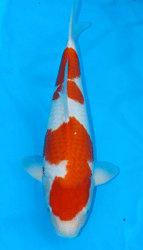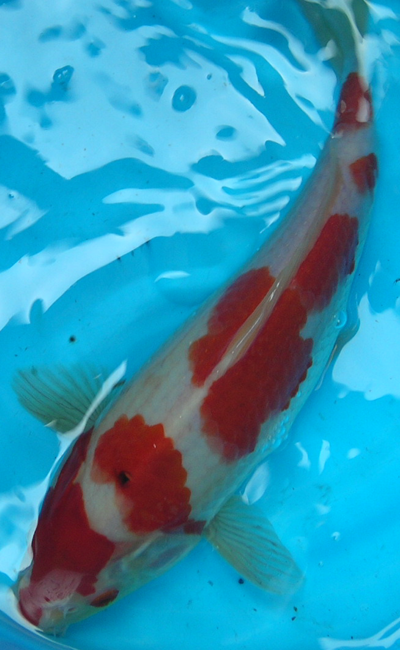What makes Koi Fish color?
The coloration of a Koi Fish is produced by three color pigments which are contained within cells called chromataphores. The three pigments are Erythrin (red), Melanin (black) and Xanthin (yellow), each of which occurs, in different chromataphores. Complementing the color pigment are irridocytes which can be best described as tiny reflective spheres within the skin.All of the colors we see on our Koi Fish are a mixture of these components. For example orange is a combination of red and yellow chromataphores; brown is a mixture of black and yellow and red is just the red chromataphores. If there are no chromataphores present the Koi will appear white due to the irridocytes However, the position of the irridocytes within the skin affects its reflective properties. If they are on the surface of the scales the Koi will have a silvery appearance. If they are in the lower layers of the skin the fish will have a mat color.
In certain cases, the irridocytes can combine with the chromataphores to produce reflective colors (e.g. gold on the surface). Blue is an unusual color in that it is a result of deep lying black pigment with irridocytes in the middle of layers of the skin. The irriclocytes interfere with the light to give a blue color.
Destiny of color
The chromatophores may be positioned on the surface of the skin (above the scales), immediately under the scales or deep in the skin. If the chromataphores are very dense the coloration will also appear dense, with the chromataphores on the surface of the skin blocking those below. However, the position of the chromataphores affects the 'stability' of the color. The chromataphores on the surface of the skin will often produce unstable coloration due to them being removed or spreading as the koi fish ages. Those deep in the skin are more stable and less likely to break up. The ideal is to have the some, dense color pigment in all layers of the skin. This results in both a dense and stable color.Where does the color come from?
Koi cannot synthesize their own color pigment therefore they have to consume it. In wild conditions the color pigments would originate from eating algae, shrimps, snails etc, In the confines of a Koi pond there is insufficient of these different organisms to satisfy the Koi's requirements, therefore it is important to feed color-enhancing foods. As with all Koi feeds, it is important that the color enhancing food given is of high quality to ensure that the pigments are in a form that the fish can absorb into its body.If color foods are not given to your Koi, the chromatophores would not be filled with pigment and the Koi will look pale or poorly colored. This can result in a Kai of high potential quality only looking mediocre. Feeding a color food would greatly enhance the appearance of such a Kai - but could not make a poor Kai great.
When the chromataphores are filled with pigment, the excess is passed through the Koi in the feces. It is possible to get white areas of the koi becoming pink due to a temporary build up of Erythrin. This pigment is not in a chromataphores and will quickly disappear as soon as the amount of color food given is reduced.
Aging
Each Koi Fish is born with a fixed number of chromotaphores which remains relatively constant throughout its life. As the Koi ages and grows, these chromataphores, have to cover a larger area of skin therefore there is a tendency for the coloration to become paler (due to the chromataphores becoming less dense) or to fragment. This helps to explain why many stunning young Koi are not as attractive when they are slightly larger. Buying young fish from a known "high quality bloodline" usually means you are buying fish with more dense chromataphores, which results in the color remaining even when the Koi has grown.In some varieties (e.g. Sanke and Showa) it is common for the pattern to change considerably as the fish grows due to the surface color fragmenting and revealing a deeper different color. When your Koi become very old they tend to become paler and in some cases turn white. This is the equivalent of our hair turning gray and cannot be reversed.
Changing Color
A chromatophore is a branched cell, within which the color pigment can be moved. The two extremes are that the pigment spreads though out the entire cell (which results in the Koi being the color of the cell) or it is concentrated in one small spot in the center (resulting in the background color showing through - usually pale or dark). The distribution of this pigment is affected by a number of different factors including:Water Quality - Different water quality conditions can have a major impact on the coloration of the Koi. Raised levels of pollutants (e.g. ammonia, nitrite or nitrate) will cause the pigment to contract, resulting in the Koi losing its color. pH and hardness affect coloration differently, red pigment tends to spread in softer, more acidic water, whereas black pigment spreads in harder more alkaline water and vice versa.
Pic 1 .This "Kohaku" No Black Spot in 10 cm size change after reach 20 cm
Background Color - Although it is difficult to merge into the background when you are a red and white Koi, they do try to do so. Against a pale background the Koi contract the pigment to make themselves as, pale as possible. The opposite occurs when the Koi is next to a dark background, which is why blue vats are used at Koi shows to ensure each Koi looks at its best.
Treatments - Salt is often added to Koi ponds as a treatment or to control nitrite toxicity, however, it causes the pigment to concentrate resulting in poorer coloration. The same is true for antibiotics, whether added to the water or injected and malachite green based remedies.
Algae - Koi (and goldfish) which have lived in an algae rich, green pond often appear intensely colored due to the color pigment spreading in the chromataphores. This effect can be recreated without the "green water' by using Tetra Pond Koi Vital.
Temperature - At high summer temperatures pigments contract; at cool autumn and winter values they expand resulting in the koi looking at their best in the cooler months of the year.
This list could be continued, but hopefully some of the examples my help to explain color changes in your Koi which you have observed. Unfortunately these things don't happen in isolation, making it very difficult to ascertain exactly what caused the coloration of your Koi, this can only be remedied by more people making more accurate records of the coloration of their Koi and what happens when conditions change.
Source : By Dr. David Pool, Tetra Reprint courtesy of Nishikigoi International via Cascade Koi & Goldfish Club

